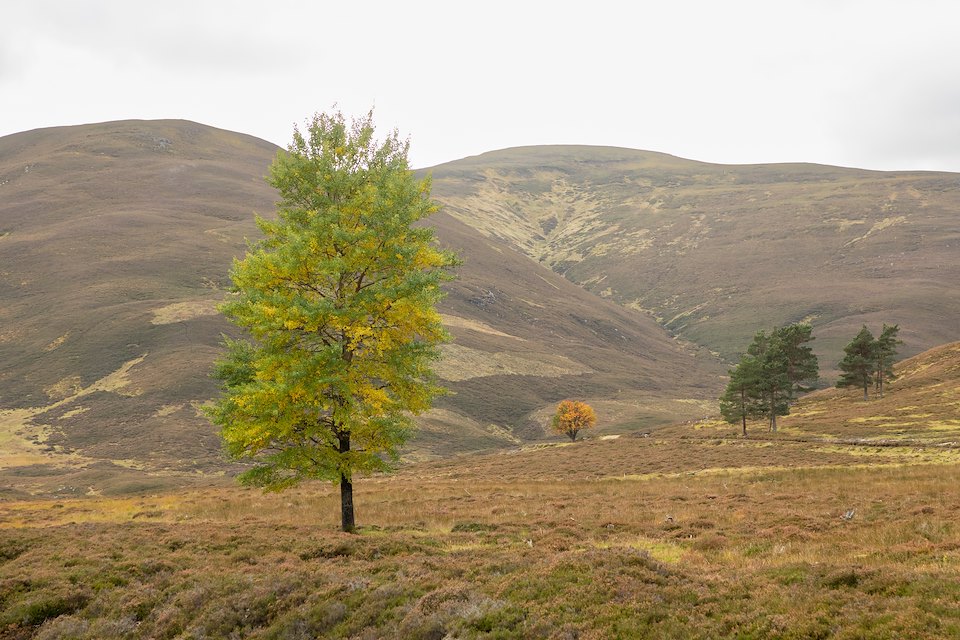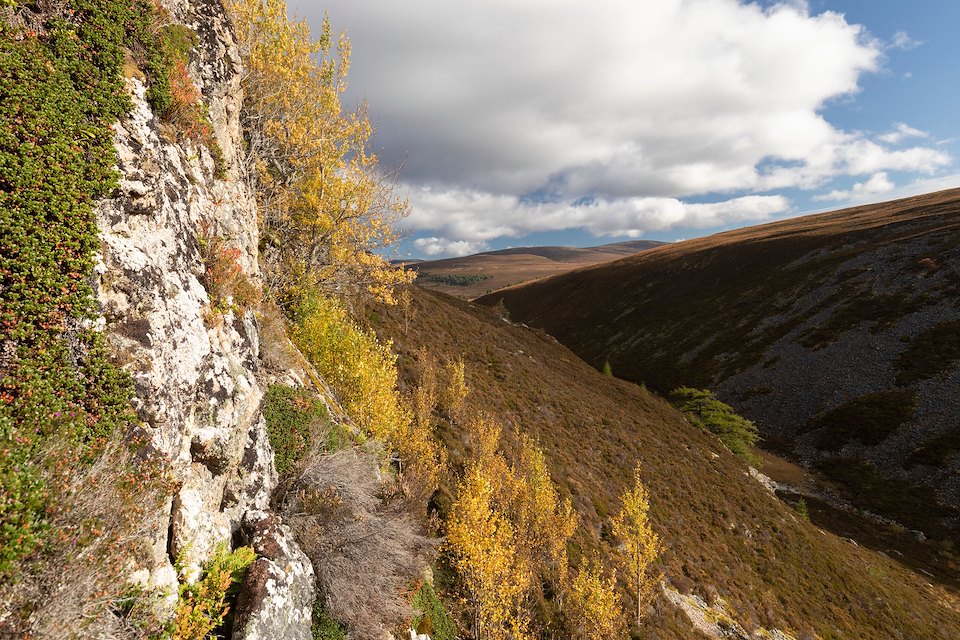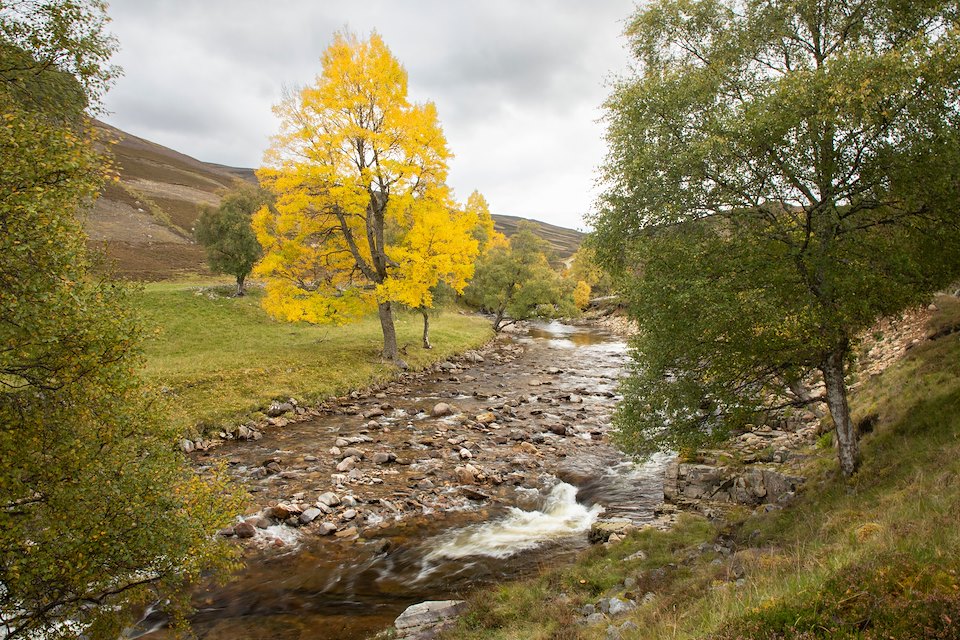A Quaking Voice Sings In The Glens
The under-recognised, under-represented aspen is on the march at Mar Lodge in the Cairngorms, where landscape-scale nature recovery is giving this unique tree the chance to sing once again.
A quiet, quaking revolution is underway. For centuries, a tree species has been biding its time, sitting unnoticed among the heather, or perched precariously on a rock face. Its leaves whisper in the wind. Just maybe, it is ready to sing again.
A quiet, quaking revolution is underway. For centuries, a tree species has been biding its time, sitting unnoticed among the heather, or perched precariously on a rock face. Its leaves whisper in the wind. Just maybe, it is ready to sing again.
Aspen is a beautiful, enigmatic tree that has fallen on hard times. It is a friend of charismatic species like beavers, and obscure ones like aspen hoverfly. By nature, it is loud, showy, prodigious; its rustling leaves announce its presence, its autumn colours are unparalleled. Yet centuries of high levels of grazing and burning in our uplands have all but silenced our aspens. Now, it slinks shyly along burns and peeks over inaccessible crags. Some trees sit primly in farmland, surrounded by grassy fields. One lone aspen I know stands isolated on the open moor, burning yellow like a beacon, while rutting stags roar over it.
We are at the nadir of the species’ fortunes in Scotland.



By all rights, aspen should be one of the most common trees in the Highlands. But then, it is an all or nothing species. It is a sprinter, suckering prodigiously, racing to grow out of the reach of hungry mouths. In parts of its huge global range, these qualities make it a familiar species, but this remarkable growth rate means that aspen puts little effort into developing chemical defences against browsing animals. Too much nibbling, for too long, and this tree disappears from the landscape, back to defensible redoubts. One or two remarkable stands have survived, like those at the Muir of Dinnet and Insh Marshes. But really, we are at the nadir of the species’ fortunes in Scotland.
Where I work, at the National Trust for Scotland’s Mar Lodge Estate in the Cairngorms, the history of aspen reflects its story across much of the Highlands. Centuries of browsing pressure have left its distribution fragmented, with its retreat coming at a significant ecological cost. The links in the life cycle between generations have been severed. Dark-bordered beauties and aspen hoverflies are gone. Wetlands of aspen and willow are gone. But the only way is up and at Mar Lodge, aspen is rediscovering its voice.
Where I work, at the National Trust for Scotland’s Mar Lodge Estate in the Cairngorms, the history of aspen reflects its story across much of the Highlands. Centuries of browsing pressure have left its distribution fragmented, with its retreat coming at a significant ecological cost. The links in the life cycle between generations have been severed. Dark-bordered beauties and aspen hoverflies are gone. Wetlands of aspen and willow are gone. But the only way is up and at Mar Lodge, aspen is rediscovering its voice.
Visitors today will see hundreds of thousands of pines, birches, willows and junipers racing up the hillsides.
Mar Lodge is big: Scotland’s largest National Nature Reserve; 30,000 hectares of ancient woodlands, peatlands and moorlands all sitting below the high tops. We have a 200-year vision to restore nature, primarily through natural processes, while at the same time promoting open access for all and delivering sustainable Highland sport in ways that align with wider ecological restoration. Back in 1995, when the Trust took on the estate, the woodlands were in a critical condition. A long history of forestry operations and high numbers of red deer for sport had left the glens a short-cropped bowling green. The estate’s magnificent pines, among the oldest in Scotland, were dying. Without young trees to replace them, the remnants of woodlands were fragmenting.
Visitors to Glens Derry, Quoich and Lui today will see hundreds of thousands of pines, birches, willows and junipers racing up the hillsides, responding to a substantial reduction in the size of Mar Lodge’s deer herd. More than 2,000 hectares of new, naturally regenerating woodland are reclaiming open ground that has not seen a tree for centuries. As one of the tastiest species for herbivores, aspens were the last to return, but we’ve slowly seen their suckers coming down from the crags, back onto the hillsides, reclaiming their rightful place in the mosaic of emerging woodland.
In 2018 we began noticing something surprising. Tiny aspens were waving in the wind, just above the heather and, weirdly, there were no other aspens in sight. These pioneering trees were sometimes hundreds of yards from the nearest mature tree. Initially, there were just one or two, here or there. Then small patches of tiny trees appeared huddled together. And then there were more. Received wisdom says that as aspen doesn’t seed well in Scotland, it relies on suckering from mature trees, and will therefore struggle to reclaim lost ground. So what was going on here?
It was enough to pique our interest and we surveyed all the known aspen stands on the estate. We found 53 patches. But as more trees announced their presence, the list kept growing and we’re now up to 80 individual stands. Over a quarter of these are comprised solely of infant trees lacking a sucker source.
Aspen regeneration well away from mature stands, could occur right across the Highlands.
We are left with two potential explanations: one, that aspen is better at seeding than we thought; or two, that aspen can survive, heavily grazed, under the surrounding vegetation, for centuries. Either way, what this shows us is that aspen is better at regenerating than we thought. And that is hugely exciting.
Here, then, is one of the benefits of rewilding writ large.
Here, then, is one of the benefits of rewilding writ large.
This phenomenon is not limited to Mar Lodge. Similar ‘spontaneous regeneration’ has also occurred at Corrour, where the estate’s deer-stalking team have recorded aspens growing on the open hill. Other sightings have occurred in Glen Affric. It’s too early to be sure, but it seems that aspen regeneration well away from mature stands, could occur right across the Highlands.
Here, then, is one of the benefits of rewilding writ large. When whole landscapes are restored, thousands of hectares at a time, nature has the space to sing its own tune, rather than the one we’ve composed for it.
Ecological restoration at this scale is spectacular, surprising. But that doesn’t mean it is the only way to return aspen to the landscape, and nor is this the only approach we are taking at Mar Lodge. In the wet, peaty south and west of the estate, where there is naturally less woodland, we are restoring a network of riverwoods among the blanket bogs and moors, creating connections between Deeside, Speyside and Atholl. Waiting for natural regeneration here would take many decades, so we have planted trees – 150,000 of them – a mixture of aspen, birch, willow, alder and pine, which for now remain behind fences. This is already paying dividends for biodiversity. Aspens planted in 2017 have been colonised by pebble prominent and puss moths.

Aspen ‘riverwoods’ alongside the Ey Burn at Mar Lodge Estate.
Another tactic is much smaller scale. Aspen is supremely suited to micro-fencing, or seed islands – 2m x 2m squares within which existing suckers can quickly re-establish. It’s a low-resource, low impact solution for places where rifles or deer fences aren’t practical. It works well.

Small fenced enclosures, or seed islands, like these at Lynbreck Croft in the northern Cairngorms, are a low-impact approach to protecting young trees that will grow and provide a seed source in the future.
The low, tremulous murmur of aspens in our glens is ready to burst into full melody.
Our largest stand of around a hundred trees sits outside the pinewoods, in pasture. It is perhaps an echo of a farming culture that valued aspen for fodder. We have temporarily taken this field out of grazing to allow the aspen suckers to expand and we’ve been richly rewarded, with thousands of young trees now surrounding the stand.
There is more than one way to help aspen sing. Adaptive management, planting, rewilding and fencing are all needed to restore the fortunes of this vital tree. Going beyond the ‘mere’ landscape scale, towards the regional, even national, scale, we need a whole suite of interventions carried out by communities, landowners and NGOs. Indeed, this is already happening up and down Deeside.
It will be many decades before we see aspen woodlands with the full range of deadwood, mature trees, young saplings and suckers working their magic. But for now, a faint song is gaining in volume. The low, tremulous murmur of aspens in our glens is ready to burst into full melody.
#PaintingScotlandYellow
Andrew Painting is an ecologist and writer working in the Cairngorms. You can find more stories about nature and people at Mar Lodge Estate in his book, Regeneration: The Rescue of a Wild Land.
This story is part of the Painting Scotland Yellow campaign. Learn more here.



